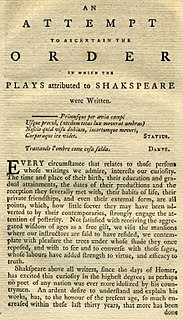
The earliest texts of William Shakespeare's works were published during the 16th and 17th centuries in quarto or folio format. Folios are large, tall volumes; quartos are smaller, roughly half the size. The publications of the latter are usually abbreviated to Q1, Q2, etc., where the letter stands for "quarto" and the number for the first, second, or third edition published.

King Lear is a tragedy written by William Shakespeare. It is based on the mythological Leir of Britain. King Lear, in preparation for his old age, divides his power and land to two of his daughters. He becomes destitute and insane and a proscribed crux of political machinations. The first known performance of any version of Shakespeare's play was on St. Stephen's Day in 1606. The three extant publications from which modern editors derive their texts are the 1608 quarto (Q1) and the 1619 quarto and the 1623 First Folio. The quarto versions differ significantly from the folio version.

This article presents a possible chronological listing of the composition of the plays of William Shakespeare.
Rollo Duke of Normandy, also known as The Bloody Brother, is a play written in collaboration by John Fletcher, Philip Massinger, Ben Jonson and George Chapman. The title character is the historical Viking duke of Normandy, Rollo. Scholars have disputed almost everything about the play; but it was probably written sometime in the 1612–24 era and later revised, perhaps in 1630 or after. In addition to the four writers cited above, the names of Nathan Field and Robert Daborne have been connected with the play by individual scholars.

Locrine is an Elizabethan play depicting the legendary Trojan founders of the nation of England and of Troynovant (London). The play presents a cluster of complex and unresolved problems for scholars of English Renaissance theatre.

Leir was a legendary king of the Britons whose story was recounted by Geoffrey of Monmouth in his pseudohistorical 12th-century History of the Kings of Britain. According to Geoffrey's genealogy of the British dynasty, Leir's reign would have occurred around the 8th century BC, around the time of the founding of Rome. The story was modified and retold by William Shakespeare in his Jacobean tragedy King Lear.

Queen Cordelia was a legendary Queen of the Britons, as recounted by Geoffrey of Monmouth. She was the youngest daughter of Leir and the second ruling queen of pre-Roman Britain. There is no independent historical evidence for her existence.

The Troublesome Reign of John, King of England, commonly called The Troublesome Reign of King John is an Elizabethan history play, probably by George Peele, that is generally accepted by scholars as the source and model that William Shakespeare employed for his own King John.
The Beaumont and Fletcher folios are two large folio collections of the stage plays of John Fletcher and his collaborators. The first was issued in 1647, and the second in 1679. The two collections were important in preserving many works of English Renaissance drama.
A Looking Glass for London and England is an Elizabethan era stage play, a collaboration between Thomas Lodge and Robert Greene. Recounting the Biblical story of Jonah and the fall of Nineveh, the play is a noteworthy example of the survival of the Medieval morality play style of drama in the period of English Renaissance theatre.
George Eld was a London printer of the Jacobean era, who produced important works of English Renaissance drama and literature, including key texts by William Shakespeare, Ben Jonson, Christopher Marlowe, and Thomas Middleton.
Nathaniel Butter was a London publisher of the early 17th century. The publisher of the first edition of Shakespeare's King Lear in 1608, he has also been regarded as one of the first publishers of a newspaper in English.

Thomas Pavier was a London publisher and bookseller of the early seventeenth century. His complex involvement in the publication of early editions of some of Shakespeare's plays, as well as plays of the Shakespeare Apocrypha, has left him with a "dubious reputation."

Holinshed's Chronicles, also known as Holinshed's Chronicles of England, Scotland, and Ireland, is a collaborative work published in several volumes and two editions, the first edition in 1577, and the second in 1587. It was a large, comprehensive description of British history published in three volumes.

The True Tragedy of Richard III is an anonymous Elizabethan history play on the subject of Richard III of England. It has attracted the attention of scholars of English Renaissance drama principally for the question of its relationship with William Shakespeare's Richard III.
The Downfall of Robert Earl of Huntingdon and The Death of Robert Earl of Huntingdon are two closely related Elizabethan-era stage plays on the Robin Hood legend, that were written by Anthony Munday in 1598 and published in 1601. They are among the relatively few surviving examples of the popular drama acted by the Admiral's Men during the Shakespearean era.

Regan is a fictional character in William Shakespeare's tragic play King Lear, named after a king of the Britons recorded by the medieval scribe Geoffrey of Monmouth.

Cordelia is a fictional character in William Shakespeare's tragic play King Lear. Cordelia is the youngest of King Lear's three daughters, and his favourite. After her elderly father offers her the opportunity to profess her love to him in return for one third of the land in his kingdom, she refuses and is banished for the majority of the play.

Goneril is a character in William Shakespeare's tragic play King Lear (1605). She is the eldest of King Lear's three daughters. Along with her sister Regan, Goneril is considered a villain, obsessed with power and overthrowing her elderly father as ruler of the kingdom of Britain.
Cordell Annesley was an English courtier.












